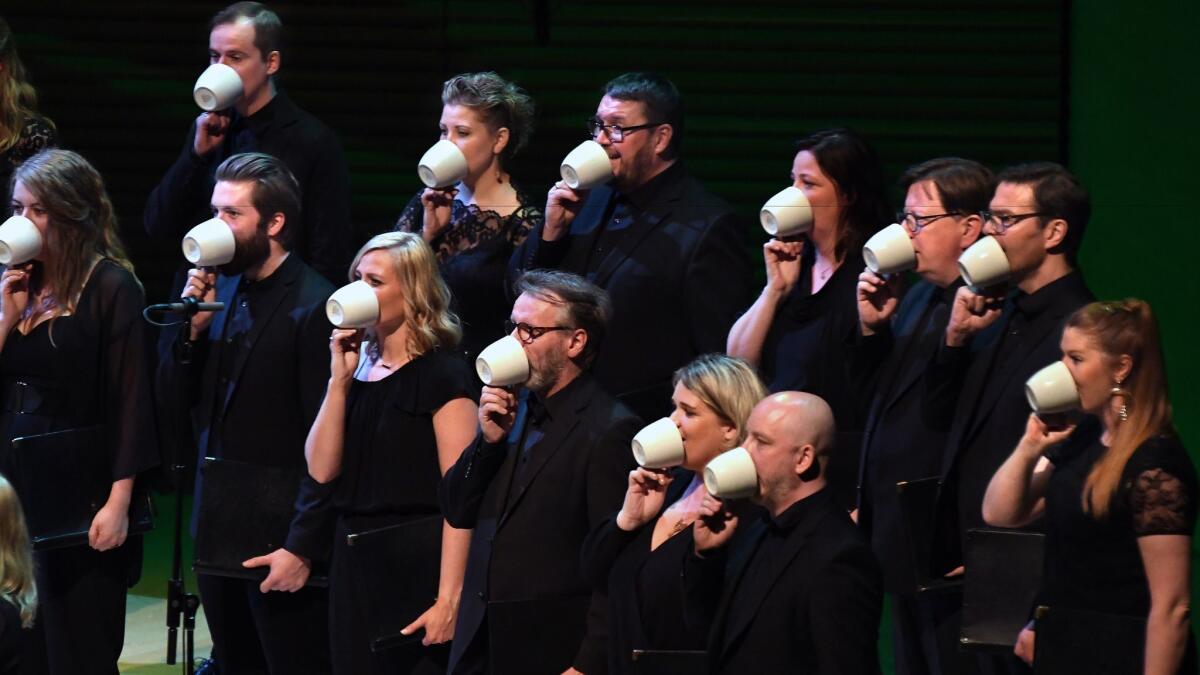Review: L.A. Philâs ReykjavĂk Festival begins with music of the Earth and singing in teacups

How and why is it that ReykjavĂk suddenly has such musical prominence? Perhaps the âwhyâ will become clearer during the Los Angeles Philharmonicâs ReykjavĂk Festival. Donât count on it, however. A dip of the toes into Icelandâs puzzling culture, much of if seemingly inspired by weirdly awesome landscapes, is only a dip of the toes.
There was, though, a helpful explanation of the âhowâ Tuesday night at the L.A. Phil New Music Groupâs Green Umbrella program. This concert served as a kind of preview to the main event: three orchestral concerts, Thursday through Saturday, that will include a host of Icelandic pieces (different each night) along with the participation of the rock band Sigur RĂłs.
On Tuesday, a pre-concert conversation between Icelandic musicologist Ărni Heimir IngĂłlfsson and composer and conductor DanĂel Bjarnason brought up a few of the unique aspects of this remote Nordic island and Europeâs least-populated country. IngĂłlfsson noted that a country the size of Indiana had a population of about 330,000, similar to that of Anaheim. Everyone knows everyone. A lot of them have the same, or very similar, names.
Plus, IngĂłlfsson explained, in a country without a long musical tradition, âpeople donât box themselves in.â A symphony orchestra first played in Iceland in 1926. Itâs a hip, new and thus contemporary scene. All but one of Tuesdayâs composers was born after 1960, and they get around. The island may breed and attract outliers, but Icelandâs young composers typically travel widely.
History and prehistoric geology often infuse the music, as it did here. Modern electronic technology is another feature; long, dark, frigid winters give Icelandic composers plenty of time indoors at the computer.
The most memorable example on the program, which was conducted by Bjarnason and featured the Schola Cantorum ReykjavĂk chamber choir along with the members of the L.A. Phil, was Thuridur JĂłnsdĂłttirâs âCylinder 49,â commissioned by the L.A. Phil for this concert and given its world premiere. Her inspiration was an ancient Edison wax cylinder of an ancient Icelandic chant recorded in 1920. On the original recording, the scratchy background noise made by the cylinder disc practically drowns out the singing.
But like faded century-ago photographs, the distortions are what make the past feel real, so it is the noise she explores. A mixed chamber ensemble makes mystifying scraping sounds, including a percussionist rubbing a teacup with a spoon, and some further haunting electronic drones.
Once she gets us to embrace the background as a place of teeming musical richness, JĂłnsdĂłttir then has the chorus sing the folk song through teacups placed over their mouths, re-creating the distant effects of hearing the long-gone singers on the wax cylinder.
Another new piece, an L.A. Phil co-commission and given its U.S. premiere, was âQuakeâ by PĂĄll Ragnar PĂĄlsson. His bio begins by noting that he was a guitarist in the Icelandic rock band Maus, exemplifying the tight-knit character of the ReykjavĂk musicians who easily blend genres. Dressed in a cream suit â Icelandic composers, more usually in black, also share a flair for high style â he looked more like an absent-minded Oxford don, and he does indeed hold a doctorate in music.
âQuake,â which is for cello solo and large chamber ensemble, is pretty much what its title suggests, the music of the ground not being steady under your feet. Nothing is settled, everything is in trills and tremolos and glissandi. The solo cello, excellently played by Saeunn ThorsteinsdĂłttir, creaks and moans. But the most effective musical quaking feels interior, evoking the quaking you feel in those first seconds when an earthquake begins, when you first sense the Earth may be moving but have no idea yet how much.
The other two U.S. premieres were Bjarnasonâs âEk ken die nag,â for chorus and five wind instruments, and Atli IngĂłlfssonâs âObject of Terrorâ for a large chamber group. Turning to the other end of the world, Bjarnason sets an Afrikaans text (the title translates as âI Know the Nightâ) â moody night, be it near Antarctica or the Arctic â that connects us all. âObject of Terrorâ is more music of distorted surfaces. Ice breaks like bombs burst.
Icelandic music is cool, flowing, not made of dramatic structures, yet it is often a call to attention. And that is how the program began, with a snare drum solo, âPrĂm,â by Ăskell MĂĄsson, who was born in 1953 and was the most senior of the composers. It starts as fanfare and then goes structurally awry. Here is yet another example of Icelandic musicâs quest for turning the sound of the Earth into song, and L.A. Phil principal percussionist Joseph Pereira made a snare drum sing.
ALSO
Why Iceland? L.A. Philâs Reykjavik Festival highlights music from an unlikely place
What you hear is what you get in âThe Encounterâ
More to Read
The biggest entertainment stories
Get our big stories about Hollywood, film, television, music, arts, culture and more right in your inbox as soon as they publish.
You may occasionally receive promotional content from the Los Angeles Times.











